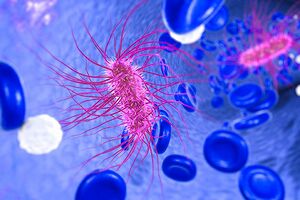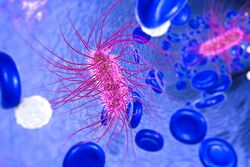E. coli and tumor colonization: Difference between revisions
No edit summary |
No edit summary |
||
| Line 9: | Line 9: | ||
Then go to YOUR OWN page; edit tab. PASTE into your own page, and edit.<br> | Then go to YOUR OWN page; edit tab. PASTE into your own page, and edit.<br> | ||
[[Image: | [[Image:E-coli-small.jpg|thumb|300px|left|Figure 1. A depiction of E. coli.[https://www.fda.gov/files/e-coli-small.jpg].]] | ||
<br>At right is a sample image insertion. It works for any image uploaded anywhere to MicrobeWiki. The insertion code consists of: | <br>At right is a sample image insertion. It works for any image uploaded anywhere to MicrobeWiki. The insertion code consists of: | ||
| Line 28: | Line 28: | ||
==Introduction== | ==Introduction== | ||
[[Image:E-coli-small.jpg|thumb|250px|left|<i>Figure 1</i>: A depiction of <i>E. coli</i>.[https://www.fda.gov/files/e-coli-small.jpg].]] | |||
<i>Escherichia coli</i> is a bacteria commonly found in the intestines of many animals, and it is used as a model organism in many labs. It thrives in a variety of locations due to it being able to respire in both aerobic and anaerobic conditions. <i>E. coli</i> has many diverse strains, with some being pathogenic, harmless, or probiotic. Numerous strains are cultured and grown for research purposes, one such example being <i>E. coli</i> Nissle 1917 (EcN). EcN was isolated in 1917 by Alfred Nissle from the feces of a German soldier. This soldier had been heavily exposed to the pathogenic bacteria Shigella, but did not exhibit any signs of infection from the pathogen. Nissle theorized that the E. coli living in the soldier’s gut had somehow protected the soldier from the Shigella infection. Nissle’s prediction turned out to be correct, as the EcN strain was highly probiotic. EcN was and still is ingested to treat bacterial infections. Genetic analysis of the EcN strain shows that it is entirely non-pathogenic, and that its probiotic effects were due to the production of proteins known as colicins. These colicins inhibit the growth of other bacteria allowing the <i>E. coli</i> to outcompete them. While non-pathogenic, the presence of EcN can still induce a general immune response. This general response can eradicate pathogenic bacteria which increases EcN’s probiotic capabilities. | |||
<br><br> | |||
==Cancer and Tumor Colonization== | ==Cancer and Tumor Colonization== | ||
Revision as of 13:21, 7 December 2022
Stuff to Steal
Select a topic about genetics or evolution in a specific organism or ecosystem.
Dominick Frost (including my name so it shows up).
The topic must include one section about microbes (bacteria, viruses, fungi, or protists). This is easy because all organisms and ecosystems have microbes.
Compose a title for your page.
Type your exact title in the Search window, then press Go. The MicrobeWiki will invite you to create a new page with this title.
Open the BIOL 116 Class 2021 template page in "edit."
Copy ALL the text from the edit window.
Then go to YOUR OWN page; edit tab. PASTE into your own page, and edit.

At right is a sample image insertion. It works for any image uploaded anywhere to MicrobeWiki. The insertion code consists of:
Double brackets: [[
Filename: PHIL_1181_lores.jpg
Thumbnail status: |thumb|
Pixel size: |300px|
Placement on page: |right|
Legend/credit: Electron micrograph of the Ebola Zaire virus. This was the first photo ever taken of the virus, on 10/13/1976. By Dr. F.A. Murphy, now at U.C. Davis, then at the CDC.
Closed double brackets: ]]
Other examples:
Bold
Italic
Subscript: H2O
Superscript: Fe3+
Introduction

Escherichia coli is a bacteria commonly found in the intestines of many animals, and it is used as a model organism in many labs. It thrives in a variety of locations due to it being able to respire in both aerobic and anaerobic conditions. E. coli has many diverse strains, with some being pathogenic, harmless, or probiotic. Numerous strains are cultured and grown for research purposes, one such example being E. coli Nissle 1917 (EcN). EcN was isolated in 1917 by Alfred Nissle from the feces of a German soldier. This soldier had been heavily exposed to the pathogenic bacteria Shigella, but did not exhibit any signs of infection from the pathogen. Nissle theorized that the E. coli living in the soldier’s gut had somehow protected the soldier from the Shigella infection. Nissle’s prediction turned out to be correct, as the EcN strain was highly probiotic. EcN was and still is ingested to treat bacterial infections. Genetic analysis of the EcN strain shows that it is entirely non-pathogenic, and that its probiotic effects were due to the production of proteins known as colicins. These colicins inhibit the growth of other bacteria allowing the E. coli to outcompete them. While non-pathogenic, the presence of EcN can still induce a general immune response. This general response can eradicate pathogenic bacteria which increases EcN’s probiotic capabilities.
Cancer and Tumor Colonization
Include some current research, with at least one image.
Sample citations: [1]
[2]
A citation code consists of a hyperlinked reference within "ref" begin and end codes.
For multiple use of the same inline citation or footnote, you can use the named references feature, choosing a name to identify the inline citation, and typing [4]
Second citation of Ref 1: [1]
Potentials of Genetic Modification
Include some current research, with a second image.
References
- ↑ 1.0 1.1 Hodgkin, J. and Partridge, F.A. "Caenorhabditis elegans meets microsporidia: the nematode killers from Paris." 2008. PLoS Biology 6:2634-2637.
- ↑ Bartlett et al.: Oncolytic viruses as therapeutic cancer vaccines. Molecular Cancer 2013 12:103.
- ↑ Lee G, Low RI, Amsterdam EA, Demaria AN, Huber PW, Mason DT. Hemodynamic effects of morphine and nalbuphine in acute myocardial infarction. Clinical Pharmacology & Therapeutics. 1981 May;29(5):576-81.
- ↑ 4.0 4.1 text of the citation
Edited by Dominick Frost, student of Joan Slonczewski for BIOL 116 Information in Living Systems, 2022, Kenyon College.
